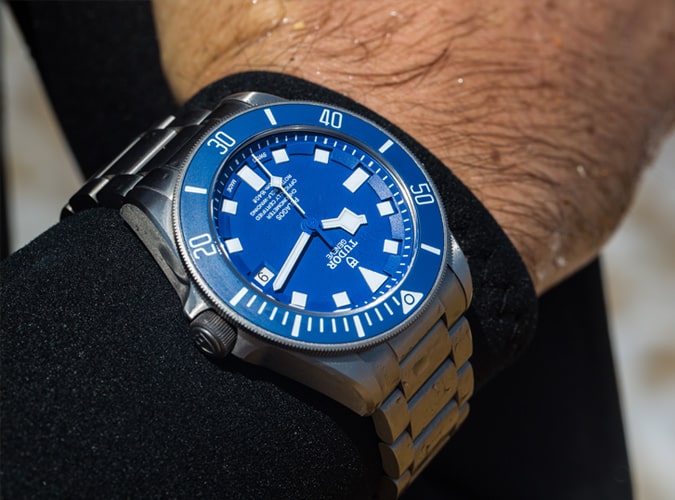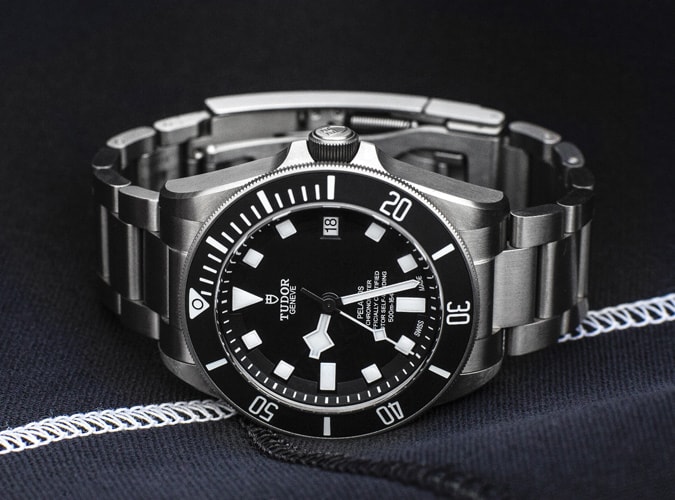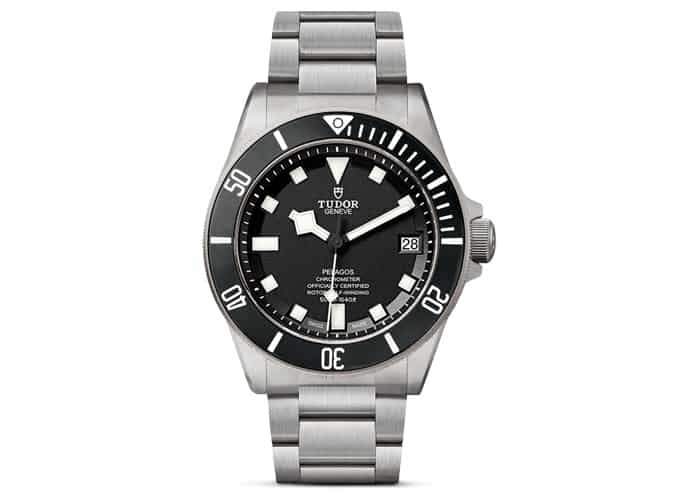It’s the diving watch that nobody can get enough of. No, not the Tudor Pelagos, which is the watch we’re actually here to talk about – rather, the Heritage Black Bay. Whether in bronze or steel, framed by a burgundy or navy aluminium bezel, it is the blue-eyed posterboy for Tudor’s recent renaissance, and a modern classic in every sense.
Yet, amazingly, this handsome waterbaby was only reissued a few years back, drawing its retro design cues from an old Tudor diving watch that went by the name, ‘Submariner’.
Sound familiar? Of course it does. Switzerland’s modern-era genius Hans Wilsdorf founded his Tudor label in 1946, forty years after launching a little brand you might know called Rolex. Named after the colourful English historical period (Wilsdorf was a self-confessed Anglophile), Tudor was built on the promise of, “a watch that our agents could sell at a more modest price, that would attain the standards of dependability for which Rolex is famous”, as Wilsdorf put it.
The Tudor Pelagos Backstory
By the mid-fifties, he had launched in parallel to Rolex’s immortal, James Bond-endorsed Submariner the Tudor equivalent, which was immediately snapped up by the era’s pioneering SCUBA hobbyists and elite naval frogmen. Cased-up in Rolex’s signature watertight ‘Oyster’ case with screwed-down crown, yet fitted with cheaper, outsourced mechanics, the Tudor Sub’ was realistically affordable kit for French Navy divers until 1981.
Despite its successes, Tudor, like so many others, was damaged by the ‘quartz crisis’ of the 1970s, when cheap Far Eastern imports hammered the traditional craft in Europe. Rolex tried its best to bail out its sibling, but Tudor eventually disappeared from the limelight, pottering along (ironically enough) in the Far East.
That is until 2010, when the ‘Heritage Chrono’ revived one of Tudor’s groovy ’70s waterbabies with a kaleidoscopic ‘Monte Carlo’ dial. Two years later and Tudor was hands-down back in the game, thanks to the launch of the Heritage Black Bay – the watch that has consolidated Tudor’s newfound identity as a colourful, nostalgic, and extraordinarily affordable brand.
Which brings us – finally! – to the Tudor Pelagos. Because, as lovely as the Black Bay is, in all its iterations, it is ultimately a tribute act. A Now That’s What I Call A Tudor Submariner greatest-hits mix of retro details, such as the famous ‘snowflake’ hours hand of 1969, the oversize crown, and the ‘Pepsi’ bezel of the GMT (aka The Watch That Won Baselworld 2018).
A Modern Day Diving Watch
The Pelagos launched quietly in the same year as the first Black Bay reboot, and was designed on a blank sheet of paper with a simple brief: make the perfect modern diving watch. Much like the Submariner back in 1953, in fact.
Nothing was overlooked and everything is just-so. It is almost impossible to see where Tudor could improve on things and sure enough, apart from 2016’s left-hand-crown version and the switch from an ETA movement to Tudor’s own top-flight MT5612 calibre a year before that, nothing else has been tweaked since 2012.

The Build Quality
Its potent cocktail of saltwater qualifications starts with the titanium case – a super-tough metal that’s incredibly tricky to engineer to diving-watch tolerances, yet lightweight, with a grey sheen that complements a two-piece suit as well as a wet one. Not only that, but Tudor’s case-making facility has managed to machine and seals up all those titanium components to a water resistance rating of 500 meters. Far beyond the reach of the finest SCUBA divers, but ‘good to know’ and hugely reassuring at that.
Then there’s the use of scratch-proof ceramic for the most prominent surface of the watch, the rotating timing bezel, meaning glances against coral (or brick walls inside trendy pubs) won’t scuff things up. The aforementioned mechanics stay self-wound thanks to an internal rotor that swings with your arm movements, but if you leave your Pelagos motionless on the dresser top on Friday night, it’ll still be ticking come Monday morning thanks to a power reserve of 70 hours (the previous ETA caliber manages a mere 42). It will have lost or gained just a few seconds, thanks to above-and-beyond levels of fine-tuning at Tudor’s watchmaking ateliers, surpassing even the strict requirements of Switzerland’s ‘COSC’ chronometer rating (the official system used to certify the precision of Swiss watches).

The Design
It’s as if Tudor has been building up to the Pelagos ever since 1954’s Submariner – and as future-forward as its physical make-up may be, what’s particularly charming is the one concession to its genetic makeup: that snowflake hours hand from 1969. Meaning it sits alongside the Black Bay collection not as the all-mod-cons show-off, but rather a more utilitarian and professionally minded offshoot.
“Though Tudor has a long history of building eminently capable dive watches,” says mad-keen SCUBA diver, free diver, and diving watch authority, Jason Heaton, “perhaps its best one is it’s most recent.
“The Pelagos has been called by many the best modern dive watch, full stop, and I’m not inclined to disagree. The minimalism is born out of pure, stripped-down utility, saved from brutal sterility by the mesmerising cerulean dial and ceramic of the Blue version.
“And then there is the clasp,” Heaton continues, “which is perhaps the Pelagos’s pièce de résistance: micro-adjustment notches allow for fine-tuning while the floating section expands to accommodate a thick wetsuit and contracts to take up slack as the suit compresses underwater pressure.”
The most impressive feature, however? The price tag. All of the above – Rolex pedigree, military heritage, future-proof engineering, in-house precision mechanics, and super-smooth styling – is yours for £3,160.


The Helium Escape Valve
As if the Pelagos’s rigorously complete package of sub-aqua features wasn’t enough, there’s a helium escape valve thrown into the bargain too. In total contrast to the primary purpose of diving watches, however, this actually has nothing to do with the pursuit of SCUBA, snorkeling, or indeed doing the washing up. Instead, it is a simple device located on the case and, invented by Rolex over 50 years ago for industrial divers working on the submerged steelwork of oil rigs for days at a time – deep ‘saturation’ dives in bathyscaphe diving bells.
The divers’ pressurized atmospheric air was saturated with helium, which, being the smallest atom, passes through the microscopic gaps of even the most rugged diving watch. Once their ‘tour of duty” was over and they returned to ambient pressure conditions, the dial crystals of their Rolex Submariners were popping off, as the helium gas inside couldn’t escape quickly enough. Rolex’s response was a remarkably simple, patented valve, located on the side of 1967’s Sea-Dweller Submariner model – also upped to 610m water resistance for good measure.
There are far too many me-too diving watches out there, unnecessarily fitted with helium escape valves – after all, the chances of deep-SCUBA-diving while wearing a watch worth thousands of pounds is slim enough; the chances of making it into an industrial bathyscaphe at the bottom of the ocean practically negligible. But as the direct descendant of Rolex’s professionally endorsed divers, the Pelagos is a rare example of a diving watch whose helium escape valve you can forgive. Expect, even.

Owning A Tudor Pelagos
How To Wear It
The great thing about a diving watch? Even if you don’t dive at all, you can realistically justify wearing one from a luxury watch brand – unlike anyone with a Porsche 911 GT3 RS who doesn’t make track days a regular fixture. You can put it on and forget about it, safe in the knowledge that a spontaneous dip in the pool or unexpected cloudburst may mess up your hair, but certainly not the delicate Swiss mechanics ticking on your wrist.
The luminous dial markings are handy for checking the time en route to your 4am bathroom visit, and you know its chunky case will survive a knock or two, whether your clambering back aboard a RIB or assembling an IKEA flatpack. For all its specialist purpose, it doesn’t even command much of a premium (unlike that race-worthy Porker) plus its voluptuous proportions and purity of design make for a discerning statement accessory. Bottom line? A Tudor Pelagos is fish, fowl, or whatever else you want it to be.


Tudor Pelagos Iterations
Black Ref. M25600TN-0001
As pure a diving watch as can be, its monochrome aesthetic working across the board, from flippers to wing-tips. Assuming your natural habitat is more land than sea however, wear this with the classic combo of black rollneck, neutral chinos and – thanks to the Pelagos’s choice of techy titanium case over classic steel – a pair of boxfresh white trainers.

Blue Ref. M25600TB-0001
Cobalt, midnight, sky… when it comes to wristwatches, much like clothes, blue is the coolest and most versatile colour. Green may be a trend having a go, salmon suits only the swarthiest of tans, but the blue dial is one trend that looks set to stay, for good reason. So hats off to Tudor for a) answering everyone’s pleas for a blue version of the Pelagos in 2015, and b) exceeding everyone’s hopes with a shade that manages to channel the Maldives shallows. So, essentially, let this watch speak for itself, pairing with a muted palette of linens, vintage Persols and an insouciant swagger fit for a Riviera quayside.

LHD Ref. M25610TNL-0001
Back in the early seventies, the story goes that the French Navy’s elite frogmen made a special request to their watch supplier, Tudor: they wanted ‘left-handed’ versions of their Submariner diving watches, which could be worn on the right wrist with the crown on the left for easy adjustment. Before, some left-handed divers had even had to make do by wearing their watches upside down.
Bringing this little-known quirk of its history to light, Tudor took everyone by surprise in late 2016 with a new edition to the Pelagos diving range, named LHD for ‘Left Hand Drive’. Crown duly on the right (enabled by simply turning the in-house mechanics by 180º, and turning the hands 180º the other way), it also comes with two tastefully retro touches: urgent-red date-window and ‘Pelagos’ markings, plus so-called ‘beige’ luminescent paint to mimic the patina of vintage models (no, really, the official grade of SuperLuminova® is ‘Beige’).
The deliberately vintage vibe, in concert with utilitarian robustness, is ‘modern urbanite creative’ through and through – as nu-hipster as it gets. Think artisan denim workwear, trucker’s cap, and an alarming passion for talking ‘craft’ over a pint of similarly crafted IPA.

The Movement
A highfalutin ‘haute horlogerie’ movement, with its hand-polished screws and finicky tourbillon carriages or perpetual calendars is all very well, but designing a utilitarian ‘base calibre’ like Tudor’s MT5612 in lieu of the long-proven, industry-standard automatics made by Swatch Group’s ETA facility is – while less romantic – a far more impressive feat.
More have to be made on an industrialised level, to similar precision and tolerances, with a longer lifespan in terms of both physical robustness and future-proofing. Setting up a base-calibre ‘manufacture’ with all its CNC milling machines and expert technicians will cost upwards of €10 million and require years of development. Tudor is clearly stepping up by several gears.
Production is stepping up, too. With 2015’s original MT5601 movement complete with power reserve function having proved its horological chops in the North Flag model, this tiny powerhouse is now driving proceedings across Tudor’s men’s line, in various subtle iterations (the Pelagos’s MT5612 comes with a handy date function).
It’s proved its chops elsewhere in Switzerland, too, with industry stalwart Breitling now adapting the MT5601 for its own chronometers in a surprise exchange deal that sees the pilot-watchmaker supplying its own in-house B01 chronograph movement back to Tudor, who, by the way, still manages to keep the price point below the equivalent Breitling chronographs. Who knows how… we’ve all stopped asking questions like that, with Tudor’s ever-ascendant capabilities and (presumably) economies of scale.








